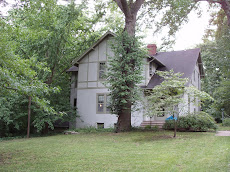My current project is building windows for the new kitchen and master bedroom additions we'll be starting in the next few weeks. In the tradition of Loving Old Stuff, I couldn't bear the thought of putting vinyl windows in the additions. And in the tradition of I Love To Save Money, I couldn't bear the thought (or cost) of buying wooden true divided-lite windows either. Just one of those babies (for a good one) can cost several hundred dollars each.
Last August, I wrote about a couple of sets of window sashes that I rescued from going to the dump. (See my previous Historic Windows post.) I mentioned in that post that I had called my friend Bob Yapp to see if I could get him to pull together enough interested people to put on a hands-on training on how to build window jambs. Window jambs are the "frames" around sashes that hold the sashes in place. After several phone calls over the course of a few months, I pestered Bob enough to get him to do a private class for me. I headed up to Hannibal, MO to Bob's Belvedere School one weekend in February, and we built the prototype window jamb that will serve as the pattern for all the double-hung jambs I will be building.
Of the two types of windows I'm building (double-hung and casements), the double-hungs are the more complicated ones. Since I have my prototype to refer to for the double-hungs, I decided to start building the casements first. Casements are nothing more than a hinged door, so I reckoned I could figure those out on my own. The one change that I made to the casements is that instead of being an out-swing window as the were in the house where they used to be installed, I am converting them to in-swing windows so I can put storm windows on the outside to make them more energy efficient. They'll also weather better since they won't be directly exposed to the elements once the storm windows are installed.
 |
| (click picture to enlarge) |
 |
| Antique, yet brand new latch |
I'm re-using the original hinges that were on these windows, but I couldn't re-use the latches because they were designed for out-swing windows. Instead, I searched online for some reproduction latches that would work for an in-swing window. Much to my delight, I found a fantastic website for a store in Cooperstown, NY that deals exclusively in "unused antique hardware". In other words, all of their hardware is really old stuff, but it is "brand new" in the sense that it has never been installed. My guess is that they must come across a few matching pieces of hardware from time to time that may have been in the basement of an old hardware store or other such place. I love these latches. They are in perfect condition, but because of their age, they already have a beautiful patina that says, "I'm old." They are better than I'd hoped for!
To make these windows energy efficient, I'm incorporating several features that will make these units on par with the efficiency of a vinyl insulated-glass window:
- Low-E glass panes
- Low-E glass on the storm window that will be attached to the outside
- Grooved stop molding that accepts silicone bead weather-strip
- Silicone sweep installed into the bottom of the sash
 |
| Grooved stop molding, showing how a small section of the silicon bead is inserted. The sash compresses the weatherstrip when the window is closed, creating an air-tight seal. |
One other product that has been incredibly useful is a two-part putty called WoodEpox by Abatron. It is an epoxy compound that can replace rotted wood, then can be sanded or machined as needed. The sash shown in the lower right had a small rotted place on one corner, which I repaired with WoodEpox. Once the sash is painted, you won't be able to tell that a repair was even made.
 |
| Groove in the bottom of the sash with the silicone sweep inserted. The white stuff in the foreground corner of the sash is WoodEpox. |
I'm having a blast building these window jambs. If I counted correctly, I have 21 windows to build. By tomorrow evening, I will have the seven casements units built, so I'll be a third of the way done. Next -- the double-hungs. And on Wednesday, I meet with our architect and the general contractor that will be shelling-in the kitchen and bedroom additions. Things are finally starting to move along!
